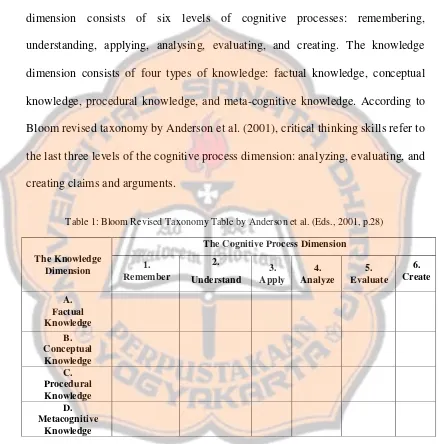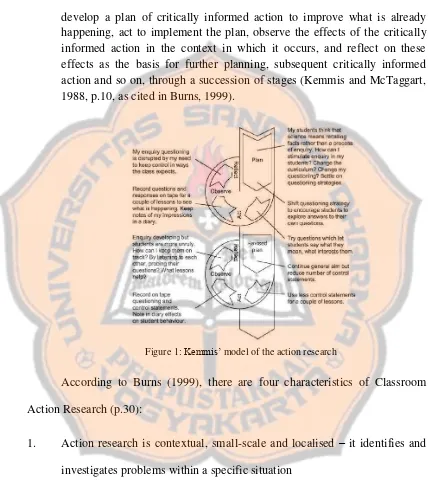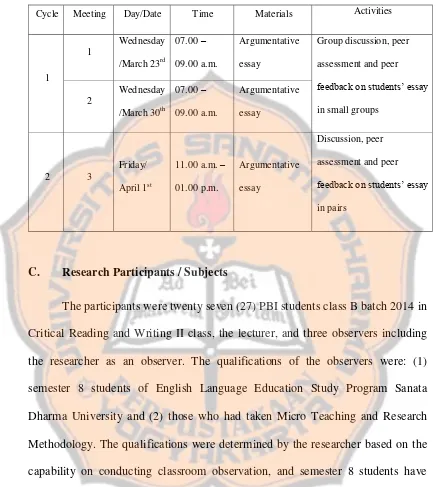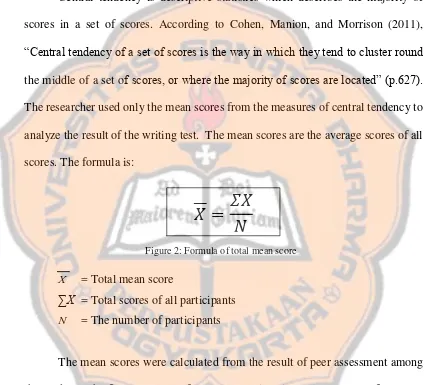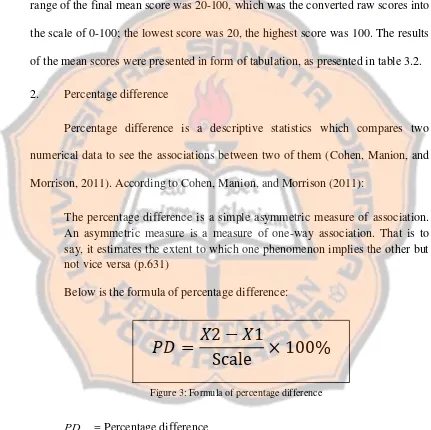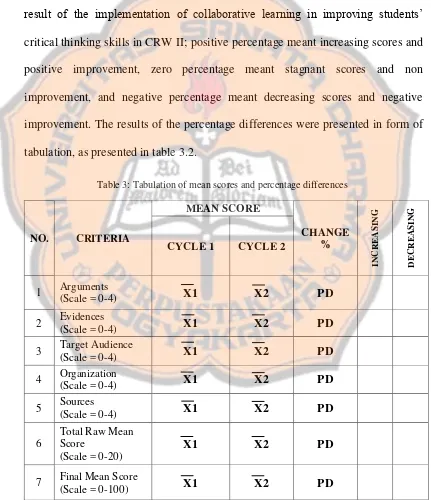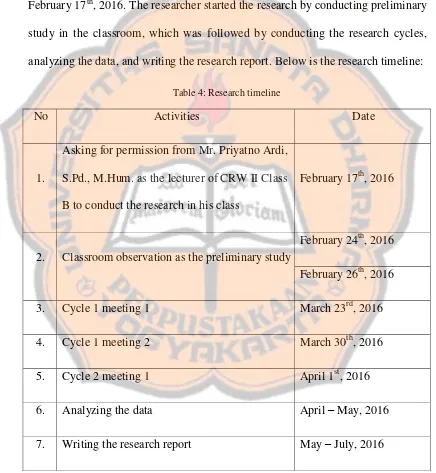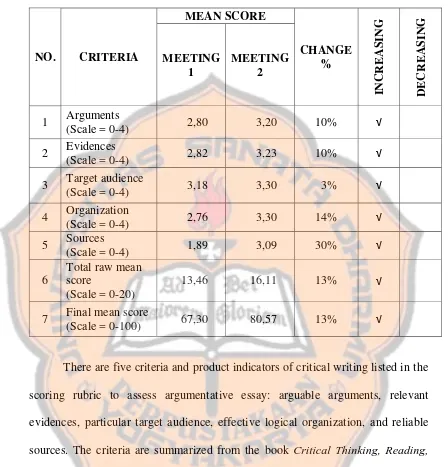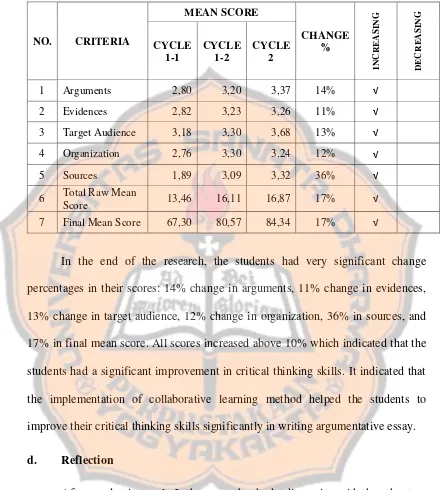vii ABSTRACT
Baskoro, Andreas Rahardjo Adi. (2015). Collaborative Learning to Improve Students’ Critical Thinking Skills in Critical Reading and Writing II Class of English Language Education Sanata Dharma University. Yogyakarta: Sanata Dharma University.
The demand from the society for the scholars to contribute in many aspects of human life and the enormous amount of available information in this globalization era are the reason for universities to improve students’ quality. This situation leads higher education to improve essential skills for their students: critical thinking skills. English Language Education Sanata Dharma University has realized the concern and answers the situation by holding a course to improve
students’ critical thinking skills: Critical Reading and Writing II. However, improving critical thinking skills was found difficult in Critical Reading and Writing II.
The research was conducted to implement collaborative learning to
improve students’ critical thinking skills in Critical Reading and Writing II Class
of English Language Education Sanata Dharma University. The research problem was formulated into two research questions: how is collaborative learning method
implemented to improve students’ critical thinking skills in CRW II? What are the
difficulties for the students to improve critical thinking skills in CRW II?
The research was designed as a classroom action research. The participants were 19 students of CRW II Class B Semester 4 English Language Education Sanata Dharma University. The research was conducted in two cycles with the implementation of peer involvement, peer assessment, and peer feedback as the collaborative learning strategies. Observation, writing test, and questionnaire were employed in the data gathering. The data analysis was qualitative data analysis in form of narrative discourse and descriptive statistics.
From the result, it was found that the implementation of collaborative learning method gave students opportunity to improve students’ critical thinking
skills in CRW II, which was indicated by students’ general attitudes of critical thinking, suspended judgements, high participation, and the significant change
percentages of students’ scores on argumentative essay (17% change percentage on final mean score).
viii
ABSTRAK
Baskoro, Andreas Rahardjo Adi. (2015). Collaborative Learning to Improve Students’ Critical Thinking Skills in Critical Reading and Writing II Class of English Language Education Sanata Dharma University. Yogyakarta: Sanata Dharma University.
Tuntutan masyarakat yang sangat tinggi terhadap para sarjana untuk berkontribusi dalam berbagai aspek masyarakat dan informasi yang sangat luas di era globalisasi merupakan alasan mengapa perguruan tinggi perlu meningkatkan kualitas mahasiswa. Situasi tersebut menyebabkan perlunya perguruan tinggi meningkatkan kemampuan yang esensial bagi para mahasiswa: daya berpikir kritis. Pendidikan Bahasa Inggris Universitas Sanata Dharma menjawab kebutuhan tersebut dengan menyelenggarakan sebuah mata kuliah: Critical Reading and Writing II. Meski demikian, peningkatan daya berpikir kritis masih menjadi hal yang sulit dalam mata kuliah tersebut.
Penelitian ini dilaksanakan untuk mengimplementasikan pembelajaran kolaboratif untuk meningkatkan daya berpikir kritis mahasiswa dalam mata kuliah Critical Reading and Writing II Pendidikan Bahasa Inggris Universitas Sanata Dharma. Pokok permasalahan dirumuskan dalam dua pertanyaan: bagaimana metode pembelajaran kolaboratif diimplementasikan untuk meningkatkan daya berpikir kritis mahasiswa di kelas CRW II? Apa kesulitan mahasiswa dalam meningkatkan daya berpikir kritis di kelas CRW II?
Penelitian ini dirancang sebagai penelitian tindakan kelas. Para partisipan merupakan 19 mahasiswa CRW II kelas B semester 4 Pendidikan Bahasa Inggris Universitas Sanata Dharma. Penelitian dilaksanakan dalam dua siklus dengan mengimplementasikan tutor sebaya, assessment sebaya, dan umpan balik sebaya sebagai strategi pembelajaran kolaboratif. Observasi, tes menulis, dan kuesioner digunakan dalam proses pengumpulan data. Data analisis menggunakan pendekatan kualitatif dalam bentuk diskursi naratif dan statistika deskriptif.
Berdasarkan hasil penelitian, telah ditemukan bahwa implementasi metode pembelajaran kolaboratif memberi kesempatan kepada mahasiswa untuk meningkatkan daya berpikir kritis di kelas CRW II; hal ini diindikasi dengan sikap berpikir kritis mahasiswa, penilaian kritis, partisipasi yang tinggi, dan persentase perubahan yang signifikan dari skor essai argumentatif mahasiswa (17% peningkatan rata-rata nilai akhir).
i
COLLABORATIVE LEARNING
TO IMPROVE
STUDENTS’
CRITICAL THINKING SKILLS
IN CRITICAL READING AND WRITING II CLASS
OF ENGLISH LANGUAGE EDUCATION
SANATA DHARMA UNIVERSITY
A
SARJANA PENDIDIKAN
THESIS
Presented as Partial Fulfillment of the Requirements to Obtain the Sarjana Pendidikan Degree
in English Language Education
By
Andreas Rahardjo Adi Baskoro Student Number: 121214146
ENGLISH LANGUAGE EDUCATION STUDY PROGRAM DEPARTMENT OF LANGUAGE AND ARTS EDUCATION FACULTY OF TEACHERS TRAINING AND EDUCATION
SANATA DHARMA UNIVERSITY YOGYAKARTA
iv
“I need to believe, that something extraordinary is possible.”
(Alicia Nash, A Beautiful Mind)
This thesis is dedicated to the eager young minds,
vii
ABSTRACT
Baskoro, Andreas Rahardjo Adi. (2015). Collaborative Learning to Improve
Students’ Critical Thinking Skills in Critical Reading and Writing II Class of
English Language Education Sanata Dharma University. Yogyakarta: Sanata Dharma University.
The demand from the society for the scholars to contribute in many aspects of human life and the enormous amount of available information in this globalization era are the reason for universities to improve students’ quality. This situation leads higher education to improve essential skills for their students: critical thinking skills. English Language Education Sanata Dharma University has realized the concern and answers the situation by holding a course to improve
students’ critical thinking skills: Critical Reading and Writing II. However, improving critical thinking skills was found difficult in Critical Reading and Writing II.
The research was conducted to implement collaborative learning to
improve students’ critical thinking skills in Critical Reading and Writing II Class
of English Language Education Sanata Dharma University. The research problem was formulated into two research questions: how is collaborative learning method
implemented to improve students’ critical thinking skills in CRW II? What are the
difficulties for the students to improve critical thinking skills in CRW II?
The research was designed as a classroom action research. The participants were 19 students of CRW II Class B Semester 4 English Language Education Sanata Dharma University. The research was conducted in two cycles with the implementation of peer involvement, peer assessment, and peer feedback as the collaborative learning strategies. Observation, writing test, and questionnaire were employed in the data gathering. The data analysis was qualitative data analysis in form of narrative discourse and descriptive statistics.
From the result, it was found that the implementation of collaborative learning method gave students opportunity to improve students’ critical thinking
skills in CRW II, which was indicated by students’ general attitudes of critical thinking, suspended judgements, high participation, and the significant change
percentages of students’ scores on argumentative essay (17% change percentage on final mean score).
viii
ABSTRAK
Baskoro, Andreas Rahardjo Adi. (2015). Collaborative Learning to Improve
Students’ Critical Thinking Skills in Critical Reading and Writing II Class of
English Language Education Sanata Dharma University. Yogyakarta: Sanata Dharma University.
Tuntutan masyarakat yang sangat tinggi terhadap para sarjana untuk berkontribusi dalam berbagai aspek masyarakat dan informasi yang sangat luas di era globalisasi merupakan alasan mengapa perguruan tinggi perlu meningkatkan kualitas mahasiswa. Situasi tersebut menyebabkan perlunya perguruan tinggi meningkatkan kemampuan yang esensial bagi para mahasiswa: daya berpikir kritis. Pendidikan Bahasa Inggris Universitas Sanata Dharma menjawab kebutuhan tersebut dengan menyelenggarakan sebuah mata kuliah: Critical Reading and Writing II. Meski demikian, peningkatan daya berpikir kritis masih menjadi hal yang sulit dalam mata kuliah tersebut.
Penelitian ini dilaksanakan untuk mengimplementasikan pembelajaran kolaboratif untuk meningkatkan daya berpikir kritis mahasiswa dalam mata kuliah Critical Reading and Writing II Pendidikan Bahasa Inggris Universitas Sanata Dharma. Pokok permasalahan dirumuskan dalam dua pertanyaan: bagaimana metode pembelajaran kolaboratif diimplementasikan untuk meningkatkan daya berpikir kritis mahasiswa di kelas CRW II? Apa kesulitan mahasiswa dalam meningkatkan daya berpikir kritis di kelas CRW II?
Penelitian ini dirancang sebagai penelitian tindakan kelas. Para partisipan merupakan 19 mahasiswa CRW II kelas B semester 4 Pendidikan Bahasa Inggris Universitas Sanata Dharma. Penelitian dilaksanakan dalam dua siklus dengan mengimplementasikan tutor sebaya, assessment sebaya, dan umpan balik sebaya sebagai strategi pembelajaran kolaboratif. Observasi, tes menulis, dan kuesioner digunakan dalam proses pengumpulan data. Data analisis menggunakan pendekatan kualitatif dalam bentuk diskursi naratif dan statistika deskriptif.
Berdasarkan hasil penelitian, telah ditemukan bahwa implementasi metode pembelajaran kolaboratif memberi kesempatan kepada mahasiswa untuk meningkatkan daya berpikir kritis di kelas CRW II; hal ini diindikasi dengan sikap berpikir kritis mahasiswa, penilaian kritis, partisipasi yang tinggi, dan persentase perubahan yang signifikan dari skor essai argumentatif mahasiswa (17% peningkatan rata-rata nilai akhir).
ix
ACKNOWLEDGEMENTS
I would express my deepest gratitude to the Lord Almighty God, for
without His blessing this thesis would not have been completely done. I am very
grateful that with His blessing, I could enjoy my struggle and reap a lot of values
along the process until this thesis was done.
My next gratitude is addressed to Drs. Pius Nurwidasa Prihatin, M.Ed.,
Ed.D., who has given me lots of critiques and advices in completing my thesis. I
am very grateful to have him as my thesis advisor; for me, he is very experienced
in managing details on thesis, which he gives and shares to his students. I was
helped with the detailed feedback from him, which helped me dealing with
practical things, even the smallest ones, which actually held important roles in
completing my thesis.
I also addressed my gratitude to Priyatno Ardi, S.Pd., M.Hum. as the
lecturer of Critical Reading and Writing II, who gave me the opportunity to
conduct my research in his class. He also gave me many advices during the
research, which helped me completing my thesis. Last but not least, I addressed
my gratitude to all people who helped me with many things during the research.
My deepest gratitude for you, who have helped me completing this thesis and my
study in this university.
May this thesis be useful to the eager young minds, who never stop
learning and dedicate their life to others.
x
TABLE OF CONTENTS
Page
TITLE PAGE i
APPROVAL PAGES ii
DEDICATION PAGE iv
STATEMENT OF WORK’S ORIGINALITY v
PERNYATAAN PERSETUJUAN PUBLIKASI vi
ABSTRACT vii
ABSTRAK viii
ACKNOWLEDGEMENTS ix
TABLE OF CONTENTS x
LIST OF TABLES xiv
LIST OF FIGURES xv
LIST OF CHARTS xvi
LIST OF APPENDICES xvii
CHAPTER I. INTRODUCTION 1
A. Research Background 1
B. Research Problems 5
C. Problem Limitation 6
D. Research Objectives 6
E. Research Benefits 6
xi
CHAPTER II. REVIEW OF RELATED LITERATURE 9
A. Theoretical Description 9
1. Defining Critical Thinking in Reading and Writing 9
2. Collaborative Learning Method to Improve Critical Thinking
Skills in Writing Argumentative Essay 14
a. Constructivism Approach as The Basis of Collaborative
Learning Method 15
b. The Benefits of Collaborative Learning Method to
Improve Students’ Critical Thinking Skills 16
c. Techniques in Collaborative Learning Method to
Improve Students’ Critical Thinking Skills 17
1) Peer Involvement 18
2) Peer Assessment 20
3) Peer Feedback 22
B. Theoretical Framework 24
CHAPTER III. RESEARCH METHODOLOGY 28
A. Research Method 28
B. Research Setting 31
C. Research Participants / Subjects 32
D. Research Instruments and Data Gathering Technique 33
1. Observation 33
2. Writing test 34
xii
E. Data Analysis Technique 36
1. Qualitative Data Analysis 37
2. Descriptive Statistics 37
F. Research Procedure 41
CHAPTER IV. RESEARCH RESULTS AND DISCUSSION 42
A. The Implementation of Collaborative Learning Method to
Improve Students’ Critical Thinking Skills in Critical Reading
and Writing II Class B Semester 4 English Language Education
Sanata Dharma University 42
1. Preliminary Study 43
2. Cycle 1 45
a. Planning 45
b. Action 47
c. Observation 50
d. Reflection 55
3. Cycle 2 58
a. Planning 58
b. Action 59
c. Observation 61
d. Reflection 66
B. Lesson Learned of Collaborative Learning Method to Improve
xiii
B Semester 4 English Language Education Sanata Dharma
University 74
CHAPTER V. CONCLUSIONS AND RECOMMENDATIONS 76
A. Conclusions 76
B. Recommendations 78
REFERENCES 80
xiv
LIST OF TABLES
Table Page
1. Bloom revised taxonomy table by Anderson et al. 11
2. Research schedule 32
3. Tabulation of mean scores and percentage differences 40
4. Research timeline 41
5. Students' scores and change percentage in cycle 1 54
6. Students' scores and change percentage in cycle 2 64
xv
LIST OF FIGURES
Figures Page
1. Kemmis’s model of the action research 29
2. Formula of total mean score 38
xvi
LIST OF CHARTS
Charts Page
1. Scoring rubric result in cycle 1 53
xvii
LIST OF APPENDICES
Appendices Page
A. Research Instruments 83
1. Observation Sheet Cycle 1 Meeting 1 84
2. Observation Sheet Cycle 1 Meeting 2 87
3. Observation Sheet Cycle 2 90
4. Questionnaire 93
5. Scoring Rubric Small Group Schematic 94
6. Scoring Rubric Pair Schematic 95
B. Lesson Plan and Teaching Material 96
1
CHAPTER I INTRODUCTION
This chapter gives the introduction of the research. The research
background explains the issues on higher education contributions to society,
globalization era, and critical thinking, which are considered as the background of
the research. This chapter also formulates the research problems and the problem
limitation, determines the research objectives, explains the research benefits, and
describes specific terms on the research.
A. Research Background
People nowadays have become a learning society. People are facing lots of
problems in many aspects: poverty, economical crisis, increasing demands of
business and industry, global warming, and many other problems to be solved.
This situation gives certain effects to higher education. Apps (1988)
mentions that learning society demands higher education to be an integral part of
the society in order to make applied solutions to solve the problems and make a
better society. As Apps (1988) states:
Within the situation, it is not enough for higher education only to conduct
research and produce scholarships. Society demands higher quality of scholars in
order to serve and contribute to the society. Therefore, universities need to
improve their students’ quality by improving not only their knowledge, but also
their way of thinking.
The demand from the society for the scholars to contribute in many aspects
of human life is not the only reason for universities to improve students’ quality,
particularly their way of thinking which affect the way they work and contribute to
the society in the future. The enormous amount of available information in this
globalization era is also considered as a concern. Meyers (1986) states, “The
amount of information available through computers and the media seems to have
outstripped people’s abilities to process and use information” (p.1). The enormous
amount of information also exceeds people’s ability to think critically upon the
information (Meyers, 1986). This situation leads higher education to improve
essential skills for their students: critical thinking skills.
Slavin (2012) defines critical thinking as “the ability to make rational
decisions about what to do or what to believe” (p.242). Critical thinking is also
defined as suspended judgement or healthy scepticism (Dewey, 1982). In language
learning context, critical thinking is defined as being healthy sceptical in assessing
claims and arguments in a text, whether the claims are supported by valid relevant
evidences and logical justifications, and building strong claims and arguments
with valid-relevant evidences and logical justifications to convince sceptical
English Language Education Study Program of Sanata Dharma University
has realized the need of critical thinking skills for their students. In order to
improve their students’ knowledge and their critical thinking skills on the four
language skills (listening, speaking, reading, and writing), ELESP makes four
courses which focus on that concern (each course contains two language skills, a
pair of perceptive and productive): Critical Listening and Speaking I (CLS I) in
semester 3, Critical Listening and Speaking II (CLS II) in semester 4, Critical
Reading and Writing I (CRW I) in semester 3, and Critical Reading and Writing II
(CRW II) in semester 4. According to Panduan Akademik Pendidikan Bahasa Inggris Universitas Sanata Dharma (2012), “Critical Reading and Writing 1 is designed to give students practice to write responses critically based on the given
texts or passages” (p.47), while Critical Listening and Speaking is described as
follow,
On completing the course, the students will be able to employ strategic skills, to comprehend intermediate extended discourse such as news reports, narratives, expository passages; paraphrase, take notes and summarize intermediate extended discourse such as news reports, narratives, and expository passages. Afterwards, the students will be able to give oral critical response and reflection based on the given topics in the form of short individual/group presentation (p.47).
To improve students’ critical thinking skills has become the main goal of both
CLS and CRW. Learning activities are conducted by the lecturers to improve
students’ critical thinking skills in those classes.
The students of CRW II still had some difficulties in improving their
research, the students still had difficulties in getting more perspective in reading
and criticizing a text, which was indicated by similar arguments stated by the
students during the classroom discussion. They also needed opportunities to have
arguments with their peers in more organized discussions to practice building
critical arguments, evaluating other people’s arguments, and to improve their
critical thinking skills; it was indicated by the lack of organized discussion for the
students to have better arguments with their peers in the classroom. The students
had to answer the demands of critical reading and critical writing; in critical
reading, students have to identify the claims and arguments of a text and be
healthy sceptical in evaluating the claims and arguments by considering the
underlying values and assessing the sources and evidences. In critical writing,
students have to build strong arguments with valid-relevant evidences and logical
structured text in order to convince the readers with the claims and arguments
(Wallace and Wray, 2011). These demands and students’ difficulties had to be
answered to help the students improve their critical thinking skills.
The researcher tried to implement collaborative learning as a solution to
help students improve critical thinking skills in CRW II. Collaborative learning is
an instructional learning method which allows students at various performance
levels to work together in small groups to reach a common goal in their learning.
Students are responsible for one another’s learning, so that they can reach
successful learning together by helping each other in their learning process
The basis of collaborative learning method is constructivism; knowledge is
constructed, and transformed by students (Dooly, 2008). Vygotsky’s socio
-cultural theory is the cornerstone of it, with Zone of Proximal Development (ZPD)
as the main core which explains that learners can achieve higher intellectual level
and enhance their critical thinking skills by doing collaborative learning rather
than individual learning (Gokhale, 1995). Collaborative learning is also important
for the students to learn how to contribute to the society. Slavin (2012) states:
In the 21st century, teamwork and the ability to solve problems and learn in groups are increasingly important in the world of work, and every student should know how to work productively with others (p.235).
This research was a Classroom Action Research. According to Kemmis and
McTaggart (1988), Classroom Action Research is a dynamic and reflective cycle
which consists of four essential processes: planning, action, observation, and
reflection. Classroom Action Research was chosen as the research design in order
to answer students’ difficulties in improving critical thinking skills which became
an immediate concern in Critical Reading and Writing II class.
B. Research Problem
According to the research background, there are two research problems to
be answered through this research:
1. How is collaborative learning method implemented to improve students’
critical thinking skills in CRW II?
2. What are the difficulties for the students to improve critical thinking skills
C. Problem Limitation
The researcher put problem limitation on students’ process and difficulties
in improving critical thinking skills in CRW II. Research scope was limited in
students’ writing on argumentative essay. Problems were limited in students’
difficulties in analyzing, evaluating, and synthesizing argumentative essay and
how students improved their critical thinking skills through collaborative learning
method in CRW II.
D. Research Objectives
The research had four objectives. The first objective was to find out the
students’ difficulties in improving critical thinking skills in analyzing, evaluating,
and synthesizing argumentative essay in CRW II. The second objective was to find
a solution for the difficulties by implementing collaborative learning method in
CRW II. The third objective was to help students and lecturers improve their
knowledge and improve critical thinking skills in their learning process in CRW II.
The last objective was to complete the thesis as a part of prerequisites for the
researcher to graduate from ELESP Sanata Dharma University.
E. Research Benefits
The research will give benefits for students and lecturer in CRW II and the
researcher. The given benefits are listed as follows:
1. Students can solve their difficulties to improve their critical thinking skills
by helping each other through collaborative learning method and to get
2. Lecturer can find an effective way to solve students’ difficulties and to help
students improve their critical thinking skills through collaborative learning
method in CRW II.
3. The researcher can deepen his knowledge on English Language teaching
and education, particularly on Critical Reading and Writing, critical
thinking, and collaborative learning.
F. Definition of Terms
Below is the definition of terms related to the research:
1. Critical thinking skills: Critical thinking is defined as being healthy
sceptical in assessing claims and arguments in a text, whether the claims
are supported by valid-relevant evidences and logical justifications, and
building strong claims and arguments with valid-relevant evidences and
logical justifications to convince sceptical readers in language learning
context, particularly in reading and writing (Wallace and Wray, 2011).
2. Collaborative learning: Collaborative learning is an instructional learning
method which allows students at various performance levels to work
together in small groups to reach a common goal in their learning. Students
are responsible for one another’s learning, so that they can reach successful
learning together by helping each other in their learning process (Gokhale,
1995). The basis is constructivism; knowledge is constructed, and
transformed by students (Dooly, 2008). Vygotsky’s socio-cultural theory is
the cornerstone of it, with Zone of Proximal Development (ZPD) as the
and enhance their critical thinking skills by doing collaborative learning
rather than individual learning (Gokhale, 1995).
3. CRW II: CRW II stands for Critical Reading and Writing II. This class is
held in semester four ELESP Sanata Dharma University after CRW in
semester three. This class aims to improve students reading and writing
skills together with critical thinking skills to bring students reading and
9
CHAPTER II
REVIEW OF RELATED LITERATURE
This chapter explains the underlying theories of the research. In the
theoretical description, all major relevant theories related to the research are
deliberated. In the theoretical framework, all major relevant theories on the
research are summarized and synthesized in order to solve the research problems.
A. Theoretical Description
In this part, all major relevant theories on the research are deliberated. The
researcher limits the theories into two parts: defining critical thinking in reading
and writing, and collaborative learning method to improve critical thinking skills
in writing argumentative essay. Further explanations are listed as follows:
1. Defining Critical Thinking in Reading and Writing
Critical thinking has been defined in various ways across different studies.
It attracts experts and philosophers to define it in many particular ways, especially
in education. In western culture, critical thinking has been closely identified in a
traditional way as discipline of logic (Meyers, 1986). Logic is considered as an
important element in critical thinking, that even “Students who have difficulty in
demonstrating critical thinking abilities are often told to take courses in logic to
Critical thinking is also defined as general problem solving skills. There are
five problem solving steps which are considered in critical thinking skills
according to Meyers (1986): “(1) recognizing and defining the problem, (2)
gathering information, (3) forming tentative conclusions, (4) testing conclusions,
and (5) evaluating and making decisions” (p.4). However, “The identification of
critical thinking with problem solving also assumes that critical thinking always
begins with a problem and ends with a solution” (Meyers, 1986, p.5). It is realized
that critical thinking does not always deal with providing a solution for a problem.
It mostly deals with evaluating claims and arguments with suspended
judgement/healthy scepticism (Dewey, 1982) and building strong claims and
arguments with valid-relevant evidences and logical justifications to convince
sceptical people (Wallace and Wray, 2011).
Healthy scepticism is considered as an important element in critical
thinking. It deals with evaluating and questioning claims and arguments in critical
thinking. It also occurs in three general attitudes in critical thinking by Meyers
(1986): raising questions, temporary suspension of one’s judgements, and
enjoyment of mysteries and complexities. These attitudes reflect a critical thinker
with healthy scepticism as the guidance.
Critical thinking is also considered as an educational goal. The definition of
critical thinking skills as educational goals can be found in Bloom revised
taxonomy. Bloom revised taxonomy is a revised edition of the original Bloom
Taxonomy of educational objectives. According to Anderson et al. (Eds., 2001),
process dimension and knowledge dimension. The two dimensions represent the
main educational objectives which are mainly classified as cognitive process as the
learning activity and knowledge as the subject matter. The cognitive process
dimension consists of six levels of cognitive processes: remembering,
understanding, applying, analysing, evaluating, and creating. The knowledge
dimension consists of four types of knowledge: factual knowledge, conceptual
knowledge, procedural knowledge, and meta-cognitive knowledge. According to
Bloom revised taxonomy by Anderson et al. (2001), critical thinking skills refer to
the last three levels of the cognitive process dimension: analyzing, evaluating, and
creating claims and arguments.
Table 1: Bloom Revised Taxonomy Table by Anderson et al. (Eds., 2001, p.28)
The Knowledge
In language learning context particularly in reading and writing, critical
thinking is defined from two different perspectives: reader’s perspective and
writer’s perspective. From reader’s perspective, critical thinking is defined as
claims are supported by valid-relevant evidences and logical justifications or not
(Wallace and Wray, 2011). A critical reader must be a sceptical person who
evaluates claims and argument in a text. Therefore, suspension on the writer’s
judgement is urgently needed to be a critical reader. Scepticism becomes an
important thing in this perspective.
From writer’s perspective, critical thinking is defined as the ability to build
strong claims and arguments with valid-relevant evidences and logical
justifications to convince sceptical people (Wallace and Wray, 2011). A critical
writer must be careful in making claims and arguments in their writing. Deep
analysis must be conducted by a critical writer on a certain issue before he or she
synthesizes and builds a claim and argument on it. Valid-relevant evidences are
also important to support claims and arguments with logical justifications. In the
end, the main goal of critical thinking in this perspective is to convince sceptical
people through a critical writing with strong and logical claims and arguments
supported by valid-relevant evidences.
Written assignment, particularly the term paper assignment, encourages
critical thinking and offers potential for demonstrating critical thinking abilities by
students (Meyers, 1986). The writing product of the paper assignment is academic
writing in form of argumentative essay. Argumentative essay gives students
opportunity to improve their critical thinking skills as a writer by building strong
arguments and justifiable claim with valid, adequate and relevant evidences and
justifications. It also gives students opportunity as a reader to be sceptical in a
justifiable claim with valid, adequate and relevant evidences and justifications
(Wallace and Wray, 2011).
There are several criteria of a text in critical writing, particularly an
argumentative essay. The criteria are used as the product indicators of students’
critical thinking skills in their critical writing in form of argumentative essay as
their learning product. Below are five criteria summarized from the book Critical Thinking, Reading, and Writing: A Brief Guide to Argument by Barnet and Bedau (2011) and the book Critical Reading and Writing for Postgraduates by Wallace and Wray (2011):
1. Arguable arguments
The essay has sharp-arguable thesis statement which is supported by
acceptable arguments, significant counter arguments and counter evidences.
2. Relevant evidences
The arguments are supported by relevant, appropriate, and convincing
evidences with persuasive material and statistical data (if possible).
3. Particular target audience
The essay is aimed at a particular audience: neutral, sympathetic, or hostile
audience on the topic. A good argumentative essay is able to persuade
neutrals to support the claim, reaffirms the sympathetic pros on their stand
on the topic, or able to change the hostile cons to support the claim. A good
4. Effective logical organization
The essay has a logical structure, coherent sequence of arguments from each
paragraph which support the thesis statement, effective introductory and
concluding paragraph.
5. Reliable sources
Reliable sources (books, journals, especially websites; websites reliability
must be carefully considered) are used to support the argumentative essay;
all quotes, summaries, and citations are well written and credited; all
borrowed words and ideas are credited.
2. Collaborative Learning Method to Improve Critical Thinking Skills in Writing Argumentative Essay
It is important for students to improve critical thinking skills nowadays.
There are many ways to improve critical thinking skills. One learning method
which is found effective to improve critical thinking skills is collaborative
learning.
Collaborative learning is an instructional learning method which allows
students at various performance levels to work together in small groups to reach a
common goal in their learning. Students are responsible for one another’s learning,
so that they can reach successful learning together by helping each other in their
a. Constructivism Approach as The Basis of Collaborative Learning Method
Collaborative learning is a learning method which is based on particular
approach as its basis. The basis of collaborative learning method is constructivism;
knowledge is constructed, and transformed by students (Dooly, 2008). According
to Bruning, Schraw, Norby, and Ronning (2004):
Constructivism is a psychological and philosophical perspective contending that individuals form or construct much of what they learn and understand. (as cited in Schunk, 2008, p. 235).
It is a learning theory which states that a person constructs most of his
knowledge by himself. Constructivism states that knowledge is constructed by
people based on their interactions with environment or situation. Therefore, human
becomes an active learner who constructs their knowledge through the interaction
between situation, social context, and their own being.
Collaborative learning is supported by Vygotsky’s theory of Zone of
Proximal Development (ZPD). It is a socio-cultural theory that has become the cornerstone of constructivist movements. According to Tudge and Scrimsher
(2003), Vygotsky’s socio-cultural theory is a constructivist theory that emphasizes
the social environment as a facilitator of development and learning (as cited in
Schunk, 2008, p. 242). Social environment is deeply considered in Vygotsky’s
theory; it helps learners to be critical in their learning process. Social interactions
in social environment help learners to coordinate three factors (interpersonal
(social), cultural-historical, and individual factors) to build a critical learning
It can be seen obviously in students’ learning experiences in the class; students
often find learning much easier by doing some group discussions together with
their friends. Vygotsky (1978) called it as Zone of Proximal Development, which is defined as:
The distance between the actual developmental level as determined by independent problem solving and the level of potential development as determined through problem solving under adult guidance or in
collaboration with more capable peers” (p. 86) (as cited in Schunk, 2008, p.
245).
There are some important elements in forming collaborative learning.
According to Slavin (1989), there must be group goals and individual
accountability to form an effective collaborative learning (as cited in Gokhale,
1995). It is the group’s task to make sure that all members get a good
understanding in their learning, while each group member has to explain the
learning materials to their friends as they are responsible on it. According to Webb
(1985), research has consistently found that those who give and receive elaborated
explanations will gain most in their learning process (as cited in Gokhale, 1995).
b. The Benefits of Collaborative Learning Method to Improve Students’ Critical Thinking Skills
Collaborative learning gives lots of benefits in learning process. There have
been lots of researches on collaborative learning. The important benefit from
collaborative learning is that it helps students to improve their critical thinking
skills. Meyers (1986) states:
The opportunity to practice critical and analytical thinking, which is stated
by Meyers, is available in collaborative learning. Dooly (2008) states that students
are encouraged to think critically by engaging in discussions and taking
responsibility for their learning, which could possibly occur in collaborative
learning. Meyers (1986) also states that to promote critical thinking in the
classroom, students have to create their own mental structures for critical thinking;
this is closely related to constructivist theory and Vygotsky’s ZPD which support
collaborative learning. Divergent perspectives and free discussions are also
important elements to encourage students to think critically in the classroom
(Slavin, 2012), and those elements are supported in collaborative learning.
Collaborative learning involves learners’ engagement in collaborative
learning process together with other learners, and the engagement involves lots of
idea and perspectives among them. Each learner has different cognitive level and
background knowledge, and it opens possibilities for them to learn beyond their
own limitation. We can see it from Vygotsky’s theory of Zone of Proximal
Development, which explains that learners can achieve higher intellectual level
and enhance their critical thinking skills by doing collaborative learning rather
than individual learning (Gokhale, 1995).
c. Techniques in Collaborative Learning Method to Improve Students’ Critical Thinking Skills
There are many techniques from collaborative learning method in
education, particularly in language learning. Three techniques from collaborative
assessment (Brown, 2004), and peer feedback (Gaies, 1985). These three
techniques were chosen and implemented in the lesson plan to respond the result
of the preliminary study of the research (further explanation on the significance of
these techniques in answering the result of the preliminary study will be explained
in chapter four). Below are the explanations of each technique:
1) Peer Involvement
Peer involvement is a technique in collaborative language learning.
According to Gaies (1985):
Peer involvement is the use of learners as models, sources of information, and interactants for each other in such a way that learners assume roles and responsibilities normally taken by a formally trained teacher (p.2).
The classical method of teacher centred learning is oppositely applied with
an active interaction between the students as peer tutors to one another. It is not
the teacher who holds the main role in the class; it is the students instead. They do
discussions and give feedback to one another in their learning process. Here, the
teacher plays his role only as an instructor and a supervisor; he gives general
instructions to the students about what they have to do and let the students
engaged in their learning process by doing peer involvement, while the teacher is
supervising their learning process.
There are several patterns of peer involvement in language learning. They
are mainly classified into two different categories: same level and cross level. The
researcher used the same level pattern in the research. Same level pattern includes
intra class tutoring, where learners come from the same class; they are in the same
inside the class. There are two options available in intra class tutoring which are
used in this research:
1. Pair work
In pair work, students work as peer tutors in pair. It gives students
opportunities to have intensive work and discussions with their pair (Gaies,
1985). They also have intensive opportunity to give peer feedback with their
pair, which will help them to give and receive good quality feedback on their
work.
2. Small group work
In small group work, students work as peer tutors in small group (Gaies,
1985). The advantage of small group work is students will get more
perspectives, which is not available in pair work. However, the quality of the
feedback might not be as good as in pair work, since the intensiveness in
small group work is lower than pair work.
Peer involvement is beneficial for language learners. Since language is
basically used for communication, peer involvement gives learners opportunities
to practice their language skills by communicating each other in such a real
situation. It also increases students’ motivation, sense of self direction, higher
intelligence level, and critical thinking skills. It breaks the limitation of teacher
centred learning where learners have limited opportunities to use and improve
their skills, which often leads learners to frustration, spoon-feeding, and negative
dependence with the teacher (Gaies, 1985). Particularly in improving critical
discussions and arguments with their peers. Dooly (2008) states that students are
encouraged to think critically by engaging in discussions and taking responsibility
for their learning, and the opportunities are available in peer involvement which
involves the students in discussions in the learning process. Peer involvement also
gives divergent perspectives which help the students in evaluating their arguments
and building strong arguments on it. Divergent perspectives and free discussions
are important elements to encourage students to think critically in the classroom
(Slavin, 2012), and those elements are supported in peer involvement.
2) Peer Assessment
Peer assessment is a part of learner-centred and collaborative education,
where the students are given the opportunity to do the language learning
assessment themselves. It is derived from self assessment where students monitor
their own learning process and performance as a successful learner. Brown (2004)
states:
Most successful learners extend the learning of process well beyond the classroom and the presence of teacher or tutor, autonomously mastering the art of self assessment. Where peers are available to render assessments, the advantage of such additional input is obvious (p.270).
There are two principles in peer assessment: the principle of autonomy and
the principle of cooperative learning. The principle of autonomy stands on
students’ abilities and autonomy as an independent learner. The abilities refer to
setting one’s own learning goals, pursuing the goals without the presence of an
external prod, and independently monitoring that pursuit (Brown, 2004). The
collaboratively with the benefits of collaborative learning. The advantages of
collaborative learning are often neglected in teaching-learning process; peer
assessment is one of many options of techniques and procedures in learner-centred
collaborative learning which bring the advantages of collaborative learning to the
learners (Brown, 2004).
There are five types of peer assessment: assessment of a specific
performance, indirect assessment of general competence, meta-cognitive
assessment for setting goals, socio-affective assessment, and student-generated test
(Brown, 2004). The research uses assessment of a specific performance in
assessing students’ writing performance. Students assess each other on written
performance by using a scoring rubric which is very suitable to use in performance
assessment. Slavin (2012) states, “Performance assessments are typically scored
according to rubrics that specify in advance the type of performance that is
expected for each activity” (p.433). Peer editing is also conducted by students in
peer assessment to give feedback to their peers.
Peer assessment gives students opportunity to practice critical and
analytical thinking to improve their critical thinking skills. Meyers (1986) states:
Students will develop good critical thinking skills only by being challenged to practice critical and analytical thinking in the context of all the different subjects they study (p.5).
Students can practice analytical thinking by assessing their peers,
particularly in analyzing their peers’ critical writing which help them to improve
learning to the learners (Brown, 2004), which helps them to improve their critical
thinking skills.
3) Peer Feedback
Peer feedback is a technique in collaborative learning method where the
learners are responsible in giving feedback to each other. The feedback is given to
signal the errors and provide the correct form to their peers in their learning
process (Gaies, 1985). Peer feedback has a practical benefit which holds a very
crucial factor in students’ learning process: students’ opportunity to receive
immediate feedback. Peer feedback allows students to give and receive feedback
immediately at the “precious moment”, which is when the students’ motivation is
high. Students can also get feedback simultaneously in the class, which is not
possible to be provided by one teacher in a single time. Peer feedback also helps
students to learn more by giving feedback to each other. (Gaies, 1985)
One option of peer feedback is student-initiated correction and editing.
Student-initiated correction and editing gives students opportunity to work in pairs
or small groups, exchange and compare their papers, and have discussion on their
papers. Feedback is given to each other in the discussion while teacher may
circulate among the students to monitor the discussion. (Gaies, 1985)
There are three advantages from student-initiated correction and editing.
The first advantage is students are going to have profitable discussions which give
them opportunity to have arguments and get critical feedback from it. The second
advantage is by having arguments in the discussion students will get positive
errors they have made. The third advantage is students are given opportunity to
sharpen their proofreading skills in correcting their peers’ papers. (Gaies, 1985)
Another effective way to improve students’ critical thinking skills is by
employing written assignment. Written assignment, particularly the term paper
assignment, encourages critical thinking and offers potential for demonstrating
critical thinking abilities by students (Meyers, 1986). The writing product of the
paper assignment in this research was academic writing in form of argumentative
essay. Argumentative essay was chosen because it gives students opportunity to
improve their critical thinking skills as a writer by building strong arguments and
justifiable claim with valid, adequate and relevant evidences and justifications. It
also gives students opportunity as a reader to be sceptical in a positive way by
assessing other students’ arguments whether the arguments are justifiable claim
with valid, adequate and relevant evidences and justifications (Wallace and Wray,
2011). In this research, collaborative learning method and written assignment in
form of argumentative essay were employed to improve students’ critical thinking
skills in CRW II.
The three techniques from collaborative learning method were
implemented in the research to improve students’ critical thinking skills. The
indicator was behavioural indicator in form of students’ participation, which
represents three general attitudes in critical thinking by Meyers (1986): raising
questions, temporary suspension of one’s judgements, and enjoyment of mysteries
as the guidance and are represented in the intensity of the students’ participation in
the discussion during the class.
B. Theoretical Framework
There were two research questions to be answered through this research.
The two research questions were answered by implementing the theories which
have been described in theoretical description. The first research question was
about the implementation of collaborative learning to improve students’ critical
thinking skills in CRW II. The theories which were implemented to answer this
research question were theories on critical thinking and collaborative learning.
Bloom revised taxonomy was used in composing the lesson plan. Critical
thinking as an educational goal was used to set critical thinking skills as a goal in
teaching-learning activities in the classroom. According to Bloom revised
taxonomy by Anderson et al. (2001), critical thinking skills refer to the last three
levels of the cognitive process dimension: analyzing, evaluating, and creating
claims and arguments. The learning objectives for the students were on these three
cognitive process dimensions.
Collaborative learning was used to structure the students learning activities
in the classroom. As stated before, collaborative learning gives certain benefits for
students to improve their critical thinking skills. Meyers (1986) states:
Students will develop good critical thinking skills only by being challenged to practice critical and analytical thinking in the context of all the different
The opportunity to practice critical and analytical thinking was available in
collaborative learning which allows students to get involved actively through
discussions.
Three techniques from collaborative learning method were implemented in
structuring students’ learning activities in the classroom: peer involvement, peer
assessment, and peer feedback. In the implementation of peer involvement, two
different types of peer involvement were used in the cycles of the action research.
Intra-class tutoring in small group work was used in the cycle 1. In small group
work, students work as peer tutors in small group (Gaies, 1985). The advantage of
small group work is students will get more perspectives, which is not available in
pair work. However, the quality of the feedback might not be as good as in pair
work, since the intensiveness in small group work is lower than pair work.
Intra-class tutoring in pair work was used in cycle 2. In pair work, students work as peer
tutors in pair. It gives students opportunities to have intensive work and
discussions with their pair (Gaies, 1985). They also have intensive opportunity to
give peer feedback with their pair, which will help them to give and receive good
quality feedback on their work.
Peer assessment was implemented during the classroom. The students do
peer-assessment by assessing each other’s critical writing in form of
argumentative essay. The type of peer assessment used was assessment of a
specific performance to assess students’ writing performance (Brown, 2004).
Students assess each other on written performance by using a scoring rubric which
students were given opportunities to do peer assessment in small group. In cycle 2,
students were given opportunities to do peer assessment in pair. The scoring rubric
was made based on the criteria of critical writing summarized from the book
Critical Thinking, Reading, and Writing: A Brief Guide to Argument by Barnet and Bedau (2011) and the book Critical Reading and Writing for Postgraduates
by Wallace and Wray (2011). Cycle 1 used small group schematic scoring rubric,
while cycle 2 used pair work schematic scoring rubric.
Peer feedback was implemented during the process of peer assessment. The
feedback is given to signal the errors and provide the correct form to their peers in
their learning process (Gaies, 1985). The type of peer feedback was
student-initiated correction and editing which gives students opportunity to work in pairs
or small groups, exchange and compare their papers, and have discussion on their
papers. Feedback is given to each other in the discussion while teacher may
circulate among the students to monitor the discussion (Gaies, 1985). In cycle 1,
students were giving peer feedback to each other in small groups. In cycle 2,
students were giving peer feedback to each other in pairs.
There were two main indicators to measure the improvement of the
students’ critical thinking skills: behavioural indicators and product indicators of
critical thinking. The behavioural indicators of critical thinking were used to
identify the improvement of the students’ critical thinking skills during the
learning process. The behavioural indicators were determined in students’
participation during the discussion. The intensity of the students’ participation
questions, temporary suspension of one’s judgements, and enjoyment of mysteries
and complexities. The product indicators of critical thinking were used to measure
the improvement of the students’ critical thinking skills in their critical writing in
form of argumentative essay as the product of their learning process. The product
indicators were determined in the criteria of critical writing summarized from the
book Critical Thinking, Reading, and Writing: A Brief Guide to Argument by Barnet and Bedau (2011) and the book Critical Reading and Writing for Postgraduates by Wallace and Wray (2011): arguable arguments, relevant evidences, particular target audience, effective logical organization, and reliable
sources.
The second research question was about students’ difficulties in improving
critical thinking skills in CRW II. The theories which were implemented to answer
the second research question were theories on critical thinking, particularly on
critical reading and writing. The criteria of critical writing (Barnet and Bedau,
2011; Wallace and Wray, 2011) were used to reflect students’ difficulties in
improving critical thinking skills in CRW II, particularly the difficulties in
reaching the five criteria in writing the argumentative essay: building arguable
arguments, using relevant evidences, aiming particular target audience, structuring
28
CHAPTER III
RESEARCH METHODOLOGY
This chapter explains the research methodology. The research method, the
setting, the participants, the instruments, the data gathering technique, the data
analysis technique, and the procedure of the research are deliberated in details in
this chapter.
A. Research Method
This research was a Classroom Action Research. According to Burns
(1999), Classroom Action Research is a research which commonly uses qualitative
research as its method to answer concrete and practical issues of immediate
concern by observing and recording events and behaviour in the classroom. It is
neither categorized in qualitative research nor quantitative research. Although its
status as a research methodology is often seen as fragile because of the strong
claims on it as a process to enhance reflective practice and professional
development, Classroom Action Research is still considered as a research
methodology by lots of teaching and learning practitioners because it requires
systematic data collection and analysis (Burns, 1999).
According to Kemmis and McTaggart (1988), Classroom Action Research
is a dynamic and reflective cycle which consists of four essential processes:
cycle which involves Classroom Action Research practitioners and the participants
to:
develop a plan of critically informed action to improve what is already happening, act to implement the plan, observe the effects of the critically informed action in the context in which it occurs, and reflect on these effects as the basis for further planning, subsequent critically informed action and so on, through a succession of stages (Kemmis and McTaggart, 1988, p.10, as cited in Burns, 1999).
Figure 1: Kemmis’ model of the action research
According to Burns (1999), there are four characteristics of Classroom
Action Research (p.30):
1. Action research is contextual, small-scale and localised – it identifies and
investigates problems within a specific situation
2. It is evaluative and reflective as it aims to bring about change and
3. It is participatory as it provides for collaborative investigation by teams of
colleagues, practitioners, and researchers
4. Changes in practice are based on the collection of information or data
which provides the impetus of change
Classroom Action Research was chosen as the research design in order to
answer students’ difficulties in improving critical thinking skills which becomes
an immediate concern in Critical Reading and Writing II class. Collaborative
Learning method was applied by the lecturer in order to find an appropriate and
effective way for the students to improve their critical thinking skills in Critical
Reading and Writing II.
During the research, the researcher played the role as a collaborator to the
lecturer. Based on the agreement with the lecturer of CRW II which was made
before conducting the research, the researcher became an observer instead of
teaching in the classroom since the responsibility of students’ academic study in
the university belongs to the lecturer, and the researcher was not supposed to take
the responsibility. The researcher collaborated with the lecturer during the research
in the cycles and each step of the Classroom Action Research: planning, action,
observation, and reflection. Therefore, the Classroom Action Research was
specifically categorized as Collaborative Action Research. The Collaborative
Action Research also gave certain benefits to the research, as Burns (1999) states:
B. Research Setting
The research was conducted in two cycles. The first cycle consisted of two
meetings and the second cycle consisted of one meeting. This research was held in
English Language Education Study Program Sanata Dharma University. The class
was Critical Reading and Writing II. The researcher became an observer in the
class without doing any intervention in order to get an authentic and natural data to
be analyzed. Discussion on the lesson plan by the researcher and the lecturer was
done a week before the cycles were started. The research was conducted in March
and April 2016.
The first cycle was conducted on March 23rd 2016 and March 30th 2016.
The researcher tried to analyze students’ progress and difficulties in improving
their critical thinking skills by doing observation on students’ activities in the
classroom and analyzing students’ score based on their peer assessment. Having
observed students’ activities, analyzed and compared students’ score from the first
meeting and the second meeting in the first cycle, the researcher found the
students’ progress and difficulties in improving their critical thinking skills. Based
on the data, the researcher made the second cycle and discussed the lesson plan
with the lecturer. The second cycle was conducted on April 1st 2016. Below is the
Table 2: Research Schedule
Cycle Meeting Day/Date Time Materials Activities
1
The participants were twenty seven (27) PBI students class B batch 2014 in
Critical Reading and Writing II class, the lecturer, and three observers including
the researcher as an observer. The qualifications of the observers were: (1)
semester 8 students of English Language Education Study Program Sanata
Dharma University and (2) those who had taken Micro Teaching and Research
Methodology. The qualifications were determined by the researcher based on the
capability on conducting classroom observation, and semester 8 students have
been taught the theories on conducting classroom observation in Research
Methodology and have practiced the theories in Micro Teaching. Nineteen (19)
students participated in the research consistently by submitting the result of their
D. Research Instruments and Data Gathering Technique
The researcher used three techniques to help the researcher collect the data
during the research. The techniques were observation, writing test, and
questionnaire. Observation was used to record teaching-learning activities in the
classroom, as Burns (1999) states that Classroom Action Research is done by
observing and recording events and behaviour in the classroom. Writing test was
used to measure students’ progress in improving critical thinking skills in writing
argumentative essay. Scoring rubric was made by the researcher to help the
students in doing peer assessment on their argumentative essay. The criteria in the
scoring rubric were considered as a standard to measure students’ progress and the
indicators in improving their critical thinking skills. Questionnaire was employed
to find the data on students’ difficulties in improving critical thinking skills. The
questionnaire consisted of open ended questions. Below are the instruments and
the data gathering techniques in details:
1. Observation
Observation was employed in cycle 1 and cycle 2 to record
teaching-learning activities in the classroom. Burns (1999) states, “It (observation) enables
researchers to document and reflect systematically upon classroom interactions
and events, as they actually occur rather than as we think they occur” (p.80). The
observation type was direct and non-participant observation. The researcher
watched and recorded the teaching and learning activities in the classroom without
personal involvement in the classroom. The purpose was to remain distant and
